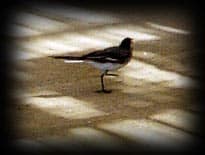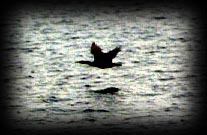Trip Report
Karpathos, Greece
September 5-23, 1999
(Note: Please give page time to load)
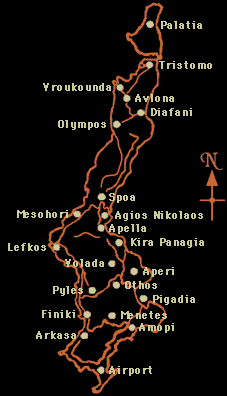
My trip to Karpathos, Greece was a combined wedding/honeymoon and also made it a birding trip when time permitted. A few pictures were taken (I’m not a very good photographer) of a female Red-backed Shrike, European Shag, White Wagtail, Willow Warbler, and Sardinian Warbler.
Note: The smaller thumbnail images are clickable. Please give it time to load since these were taken with a panoramic camera. They are well worth the wait.
At the end of this report is a systematic list of observed birds during the period September 5-23 (excluding September 12 which was my wedding day).
Location:
Karpathos is located in the Southeast corner of the Aegean Sea and is the second largest of the Dodecanese (meaning 12 Islands) Islands, Rhodes being the largest. Neighboring Karpathos in the North is a small island, Saria and in the Southwest the Island of Kassos. Karpathos is a long narrow mountainous island between Rhodes and Crete and is 48km (30.14 miles) long and 15km (9.3 miles) wide with a surface area of 301 sq. km (116 sq. miles). The island stretches in a north-south direction where the highest elevation (Kali Limni) rises 1215m over the Mediterranean.
The islands coastline is rugged and steep with some small bays and beautiful beaches while the interior of the island is very mountainous.
Vegetation:
Most of the island is covered with pine trees, some deciduous trees, tamarisks, junipers, cypresses, myrtle, shrubs, olive groves, many different herbs (oregano, sage, thyme, rosemary), vineyards and orchards consisting of lemons, almonds, walnuts, figs, oranges, grapefruit and pomegranates.
Climate:
The climate was warm and sunny (about 80 degrees), little humidity and only 1 day of rain. Typically, the islands climate in the summer is hot and rainless with very little humidity and the winters are mild. The rainy season is from December to February. The average monthly temperature in July is about 85 Degrees and goes down to about 45 Degrees in January.
General:
At present, the population of the Island is approximately 6,000 of which ~2,000 live in the village of Pigadia (recently renamed to Karpathos) and houses the principal port, hotels, restaurants, taverns, tourist and travel agencies, shops, etc.
There are approximately 13 villages on the island and almost as many small hamlets. The villages are Pigadia (Karpathos), Aperi, Arkasa, Diafani, Finiki, Lefkos, Menetes, Olympos, Othos, Pyles, Spoa, Mesochori, Volada and some of the smaller hamlets are Amopi, Afiartis, Apella, Ahata, Kyra Panagia, Ayios Nikolaos.
Places/Villages Visited:
| South Pigadia (Also known as the Mandra):
This is where I stayed from September 6-23. These apartments are located South of the village of Pigadia (about a 20 minute walk) and faces the Aeagen Sea. The apartments reside on approximately 5 acres and is surrounded by conifers, shrubs and rocky terrain. On the property, there are fig trees, olive trees, cactus (prickly pears), pomegranates, grape vines, many different herbs such as rosemary, oregano, pot marjoram (great for heartburn and stomach pains), thyme, and basil. Flowers consist of 4-O’clock bushes, Bougainvilleas, Geraniums, scented Geraniums and Roses. Birds seen on the property/perimeter: Sardinian Warbler – (Many seen everyday) |
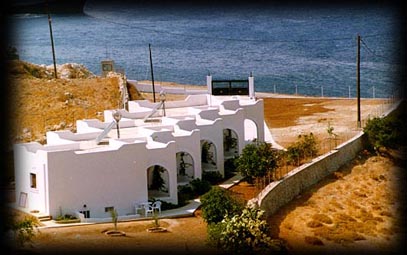 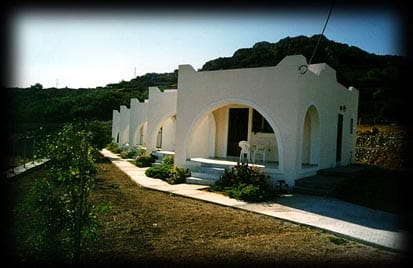 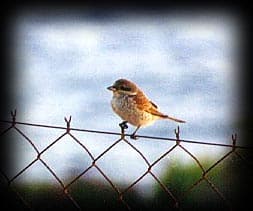 Above bird is of a Female Red-backed Shrike |
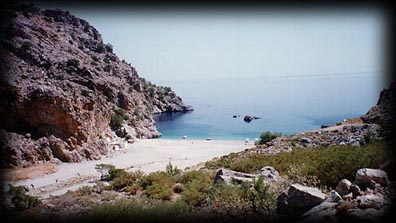 |
Ahata (September 8):
This area is rocky with conifers and many shrubs located behind the beach. The beach is partial sand and pebbles and is sheltered by rock formations. Kingfishers can be seen flying from one rock formation to another skimming the sea; while Blue Rock Thrushes can be seen on the cliffs. The Kingfishers are all so colorful with deep blue/green backs and a bright orange breast. When these little jewels are flying/skimming the ocean in the sunlight, they look iridescent with rainbow colors. If you like the North American Belted Kingfisher you would think that you are in heaven when you see the Common Kingfisher! Common Raven (2 examples)
|
Amopi (September 9):Amopi has 3 beaches and the picture to the right is of the “Mikri Amopi” which means “small Amopi”. Among the fig trees, you will find Garden Warblers and other warblers such as Willows and Sardinians.Peregrine Falcon – (1 example on road to Amopi/Menetes) Sardinian Warbler – (4 examples) European Goldfinch – (3 examples) Common Kingfisher – (2 examples) Willow Warbler – (2 examples) Common Kestrel – (1 example) 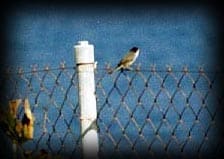
Sardinian Warbler |
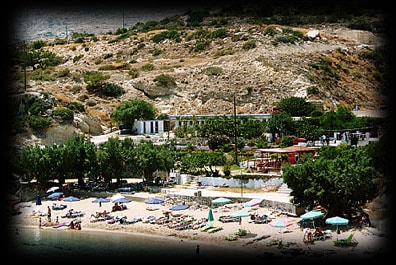 |
| Ayios Nikolaos (September 11):
Ayios Nikolaos is very small and the road was rough with alot of curves, but well worth the beautiful scenery. A Crested Lark was found on the side of the dirt road on the way back from Ayios Nikolaos. Woodchat Shrike – (1 example) |
Apella (September 14):
Oh, my favoriate place! This beach is all so quiet, small white pebbles, very few people and has one restaurant (about a 10 minute walk) where a White Wagtail was seen. Behind the beach is a rocky path that leads you into areas of pines and shrubs. The only sounds I heard on this path are Sardinian Warblers. Common Tern (1 example seen between Kyra Panagia and Apella) Bird: White Wagtail |
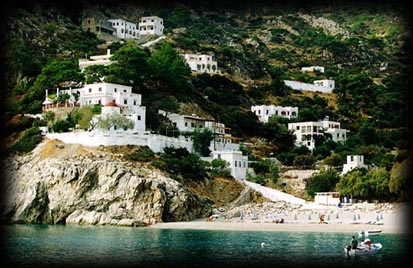 |
Kyra Panagia (September 15):
When looking at this area from at boat out at sea, it looks as though the buildings were built in rock. On the road to Kyra Panagia, I have never seen such beautiful scenery. Garden Warbler – (1 example) |
| Myli Valley (September, 17):
This area is west of the village of Pigadia and is known as the Mill Valley for the wind mills that once existed here. There is a river bed, now dry, but flows in Winter and Spring where many water birds such as herons, Glossy Ibis, bitterns, and crakes can be found during these months. Crested Lark – (1 example) |
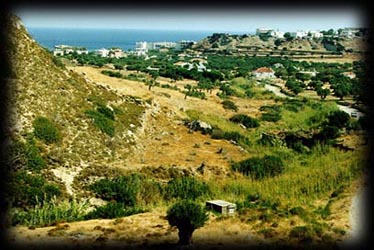 |
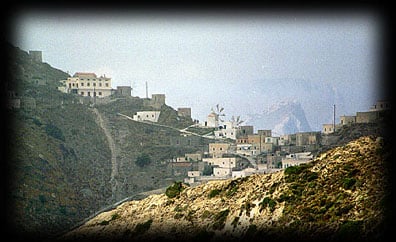 |
Diafani/Olympos (September 18):The best way to Diafani and Olympos is by boat. On the way from Pigadia to Diafani, Shags were seen.
Above Bird: European Shag The Village of Olympos is located on the top of the mountain and this village still preserves the island’s costume and customs. On the bus trip from Diafani to Olympos when you reach to top of the mountain, it is absolutely breathtaking. There is only 1 road to this village. Within the village, there are steps and the people use donkeys/mules to haul goods and building supplies. The women wear tall/heavy leather boots to protect them from the phygana (low growing prickly plants). European Shag (2 seen on boat trip to Diafani) |
| Lefkos (September 20):
Three (3) Mallards were found swimming at the bay where fishermen fish. Behind the beach, which is where this picture of the bay was taken, there are trees and a cement wall where I sat and observed the warblers. A Woodchat Shrike was sitting on a telephone wire on the way down to the sea. Woodchat Shrike – (1 example) |
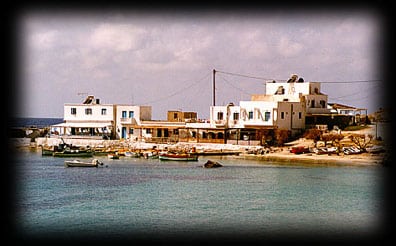 |
| Other locations briefly visited:
Chukar – (flock of 10+ taking low-heavy flight on 9-15 on road to Ayios Georgious) |
 Picture from road to Ayios Georgious (St. George) Monastery 
Ayios Georgious (St. George) Monastery |
Comments:
I did not witness any bird hunting, but did see 2 European Goldfinches in a cage at the Aquaella Cafe in Pigadia. When I approached the cafe owner about the birds, he was not interested in talking to me and walked away!
Every day moths (approx. 1″ of unknown species) were seen feeding on the Bougainvillea flowers and on the evening of September 16, a “hummingbird moth” (for lack of common/scientific name) the size of a Ruby-throat Hummingbird was seen drawing nectar from flowers of a 4-O’Clock bush. If anyone knows the common/scientific name of these moths, please send me email at [email protected]. Every evening between the hours of 9:30PM and 11:15PM, we witnessed up to 7 meteorites.
I was somewhat disappointed with the small number of species that were seen, but considering the size of the island, it’s location, time of year, and habitats, the birds (resident or passing migrant) found optimal conditions and niches on the island.
Systematic List of Birds Observed (Sibley & Monroe, 1990, includes changes from the 1993 Supplement):
- Chukar (Alectoris chukar)
- Mallard (Anas platyrhynchos)
- Eurasian Wryneck (Jynx torquilla)
- Eurasian Hoopoe (Upupa epops)
- Common Kingfisher (Alcedo atthis)
- European Bee-eater (Merops apiaster)
- Alpine Swift (Tachymarptis melba)
- Common Swift (Apus apus)
- Pallid Swift (Apus pallidus)
- Eurasian Nightjar (Caprimulgus europaeus)
- Eurasian Collared-Dove (Streptopelia decaocto)
- Common Sandpiper (Tringa hypoleucos)
- Yellow-Legged Gull (Larus cachinnans)
- Common Tern (Sterna hirundo)
- Bonelli’s Eagle (Hieraaetus fasciatus)
- Common Kestrel (Falco tinnunculus)
- Eleonora’s Falcon (Falco eleonorae)
- Peregrine Falcon (Falco peregrinus)
- European Shag (Phalacrocorax aristotelis)
- Grey Heron (Ardea cinerea)
- Red-backed Shrike (Lanius collurio)
- Woodchat Shrike (Lanius senator)
- Common Raven (Corvus corax)
- Blue Rock-Thrush (Monticola solitarius)
- Spotted Flycatcher (Muscicapa striata)
- Common Nightingale (Luscinia megarhynchos)
- Whinchat (Saxicola rubetra)
- Northern Wheatear (Oenanthe oenanthe)
- Black-eared Wheatear (Oenanthe hispanica)
- Pied Wheatear (Oenanthe pleschanka)
- Winter Wren (Troglodytes troglodytes)
- Barn Swallow (Hirundo rustica)
- Red-rumped Swallow (Hirundo daurica)
- Northern House-Martin (Delichon urbica)
- Cetti’s Warbler (Cettia cetti)
- Eurasian Reed-Warbler (Acrocephalus scirpaceus)
- Olivaceous Warbler (Hippolais pallida)
- Willow Warbler (Phylloscopus trochilus)
- Blackcap (Sylvia atricapilla)
- Garden Warbler (Sylvia borin)
- Common Whitethroat (Sylvia communis)
- Rueppell’s Warbler (Sylvia rueppelli)
- Sardinian Warbler (Sylvia melanocephala)
- Greater Short-toed Lark (Calandrella brachydactyla)
- Crested Lark (Galerida cristata)
- House Sparrow (Passer domesticus)
- White Wagtail (Motacilla alba)
- Tawny Pipit (Anthus campestris)
- Chaffinch (Fringilla coelebs)
- European Greenfinch (Carduelis chloris)
- European Goldfinch (Carduelis carduelis)
- Eurasian Linnet (Carduelis cannabina)





